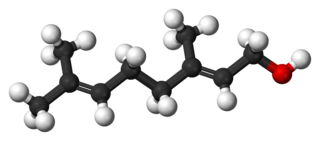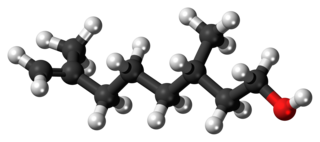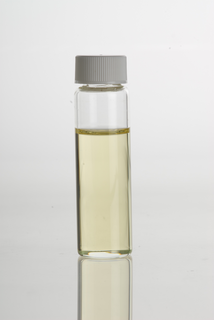
The bay leaf is an aromatic leaf commonly used in cooking. It can be used whole or in a dried or ground form.

Rose water is a flavoured water made by steeping rose petals in water. It is the hydrosol portion of the distillate of rose petals, a by-product of the production of rose oil for use in perfume. Rose water is also used to flavour food, as a component in some cosmetic and medical preparations, and for religious purposes throughout Asia and Europe.

Aloysia citrodora, lemon verbena, is a species of flowering plant in the verbena family Verbenaceae, native to South America. Other common names include lemon beebrush. It was brought to Europe by the Spanish and the Portuguese in the 17th century and cultivated for its oil.

The Muscat family of grapes includes over 200 grape varieties belonging to the Vitis vinifera species that have been used in wine production and as raisin and table grapes around the globe for many centuries. Their colors range from white, to yellow, to pink to near black. Muscat grapes and wines almost always have a pronounced sweet floral aroma. The breadth and number of varieties of Muscat suggest that it is perhaps the oldest domesticated grape variety, and there are theories that most families within the Vitis vinifera grape variety are descended from the Muscat variety.

Geraniol is a monoterpenoid and an alcohol. It is the primary component of citronella oil and is a primary component of rose oil, palmarosa oil. It is a colorless oil, although commercial samples can appear yellow. It has low solubility in water, but it is soluble in common organic solvents. The functional group derived from geraniol is called geranyl.

Rhodinol is the chemical compound 3,7-dimethyloct-7-en-1-ol. As the (3S) isomer it is CAS 6812-78-8, and as the racemate it is CAS 141-25-3.

Citral is an acyclic monoterpene aldehyde, and being a monoterpene, it is made of two isoprene units. Citral is a collective term which covers two geometric isomers that have their own separate names; the E-isomer is named geranial (trans-citral) or citral A. The Z-isomer is named neral (cis-citral) or citral B. These stereoisomers occur as a mixture, not necessarily racemic; e.g. in essential oil of Australian ginger, the neral to geranial ratio is 0.61.

Rose oil is the essential oil extracted from the petals of various types of rose. Rose ottos are extracted through steam distillation, while rose absolutes are obtained through solvent extraction, the absolute being used more commonly in perfumery. The production technique originated in Persia. Even with their high price and the advent of organic synthesis, rose oils are still perhaps the most widely used essential oil in perfumery.

Myrcene, or β-myrcene, is an alkene natural hydrocarbon. It is more precisely classified as a monoterpene. Monoterpenes are dimers of isoprenoid precursors, and myrcene is the primary component of the essential oil of the South African Adenandra villosa (50%), Myrcene is also found in bay, cannabis, and hops. It is produced mainly semi-synthetically from Myrcia, from which it gets its name. It is an intermediate in the production of several fragrances. α-Myrcene is the name for the structural isomer 2-methyl-6-methylene-1,7-octadiene, which has not been found in nature.

Citronellol, or dihydrogeraniol, is a natural acyclic monoterpenoid. Both enantiomers occur in nature. (+)-Citronellol, which is found in citronella oils, including Cymbopogon nardus (50%), is the more common isomer. (−)-Citronellol is found in the oils of rose (18–55%) and Pelargonium geraniums.

Ocimenes are a group of isomeric hydrocarbons. The ocimenes are monoterpenes found within a variety of plants and fruits. α-Ocimene and the two β-ocimenes differ in the position of the isolated double bond: it is terminal in the alpha isomer. α-Ocimene is cis-3,7-dimethyl-1,3,7-octatriene. β-Ocimene is trans-3,7-dimethyl-1,3,6-octatriene. β-Ocimene exists in two stereoisomeric forms, cis and trans, with respect to the central double bond. The ocimenes are often found naturally as mixtures of the various forms. The mixture, as well as the pure compounds, are oils with a pleasant odor. They are used in perfumery for their sweet herbal scent, and are believed to act as plant defense and have anti-fungal properties. Like the related acyclic terpene myrcene, ocimenes are unstable in air. Like other terpenes, the ocimenes are nearly insoluble in water, but soluble in common organic solvents.
Monoterpenes are a class of terpenes that consist of two isoprene units and have the molecular formula C10H16. Monoterpenes may be linear (acyclic) or contain rings (monocyclic and bicyclic). Modified terpenes, such as those containing oxygen functionality or missing a methyl group, are called monoterpenoids. Monoterpenes and monoterpenoids are diverse. They have relevance to the pharmaceutical, cosmetic, agricultural, and food industries.

Dimethylallyltranstransferase (DMATT), also known as farnesylpyrophosphate synthase (FPPS) or as farnesyldiphosphate synthase (FDPS), is an enzyme that in humans is encoded by the FDPS gene and catalyzes the transformation of dimethylallylpyrophosphate (DMAPP) and isopentenyl pyrophosphate (IPP) into farnesylpyrophosphate (FPP).
In enzymology, a dimethylallylcistransferase is an enzyme that catalyzes the chemical reaction
The molecular formula C10H18O (molar mass : 154.25 g/mol) may refer to:
Geraniol 8-hydroxylase (EC 1.14.14.83, Formerly EC 1.14.13.152, CYP76B6, G10H, CrG10H, SmG10H) is an enzyme with systematic name geraniol,NADPH:oxygen oxidoreductase (8-hydroxylating). This enzyme catalyses the following chemical reaction
Linalool dehydratase (EC 4.2.1.127, linalool hydro-lyase (myrcene-forming)) is an enzyme with systematic name (3S)-linalool hydro-lyase (myrcene-forming). This enzyme catalyses the following chemical reaction
Geraniol isomerase is an enzyme with systematic name geraniol hydroxymutase. This enzyme catalyses the following chemical reaction

Nerolic acid, also known as (Z)-3,7-Dimethyl-2,6-octadienoic acid is one of seven chemicals found in the Nasonov scent gland of honey-bees along with geraniol, geranic acid, (E)-citral, (Z)-citral, (E,E)-farnesol, and nerol. Of these, nerolic acid, geraniol, and (E,E)-farnesol are present in the highest proportions.

Helichrysum stoechas, known as Mediterranean strawflower, curry plant, or eternal flower, is an annual or perennial shrub that prefers dry, rocky and sandy areas. It can grow up to 120 centimeters in height, and spreads over 1 square meter in area. It is a hermaphrodite that has grayish green leaves and produces small globular yellow flowers sometimes in the Spring or in July and August that are pollinated by insects.















